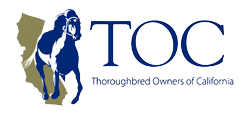Time – It’s All Relative
Time is of the essence. At least that’s what some people think. Racehorses, however, are not as conscious of time as their human counterparts. How fast a horse goes depends a little bit on training, a little on luck, and a lot on class. While it is important to understand how horses are timed on the track, both during the races and morning workouts, understanding your horse’s class and running style will tell you much more about a workout or race than your stopwatch.
Let’s say your trainer calls to report on your horse’s morning workout. “He worked six furlongs in 1:13 1/5”, your trainer states. Your first question should be, ‘How did he do it?’ Knowing how easily your horse traveled will tell more about his ability than the actual time. At least that’s what some trainers say. There are others who don’t bother to carry a stopwatch and only check time fractions during a race to determine the pace for their horse. Everyone looks for something different when asked about time, so be sure to find out from your trainer what is important.
Time is frequently used as a measure of how a horse is preparing for a race or has performed in the past. To some, results from a stopwatch indicate when a horse is ready to run, while others prefer to use workout times along with visual impressions to determine preparedness for racing. What makes time, as it relates to racehorses, so subjective is that time only measures how fast the horse is running, not the manner in which he is traveling. The factors that contribute to how fast or slow a horse works during the morning are limitless. Probably the most important factor is your horse’s running style. If your horse is a closer (comes from off the pace), he may work the first 1/2 mile to 5/8th slowly and then work the final 1/8th a second or two faster. If your horse is a sprinter, each 1/8th of a mile may be a second faster than the work of an average horse. Horses that work in company (with more than one horse) exert more energy than those working alone, which could contribute to a faster workout.
Horses, on average, run 1/8th of a mile in 12 to 13 seconds. At six furlongs, a fast workout may be between 1:11 and 1:12, while a slow workout may be between 1:15 and 1:17. During the afternoon races, a fast time for the same distance may be between 1:08 and 1:09, while a slow time would be between 1:12 and 1:13. When analyzing time, don’t forget the pace of a race usually determines the outcome. For example, if the first quarter is too fast the leading horses will get tired and not be able to finish. If it is too slow, the pacesetters will not get as tired and therefore may not be as easily caught at the wire.
Additionally, the surfaces on which your horse works and runs and track conditions contribute to the time of a workout or race. Dirt races are typically faster than turf (grass) races and dry tracks are usually faster than muddy tracks. As the morning turns into afternoon, final times take on an added significance, especially to fans in the grandstand and owners in the box seats. A maiden winner who runs six furlongs in 1:09 may turn out to be a future stakes winner, while the maiden horse that finishes in 1:13 is definitely for sale.
Written by Lucinda Mandella, TOC’s former Owners’ Liaison
